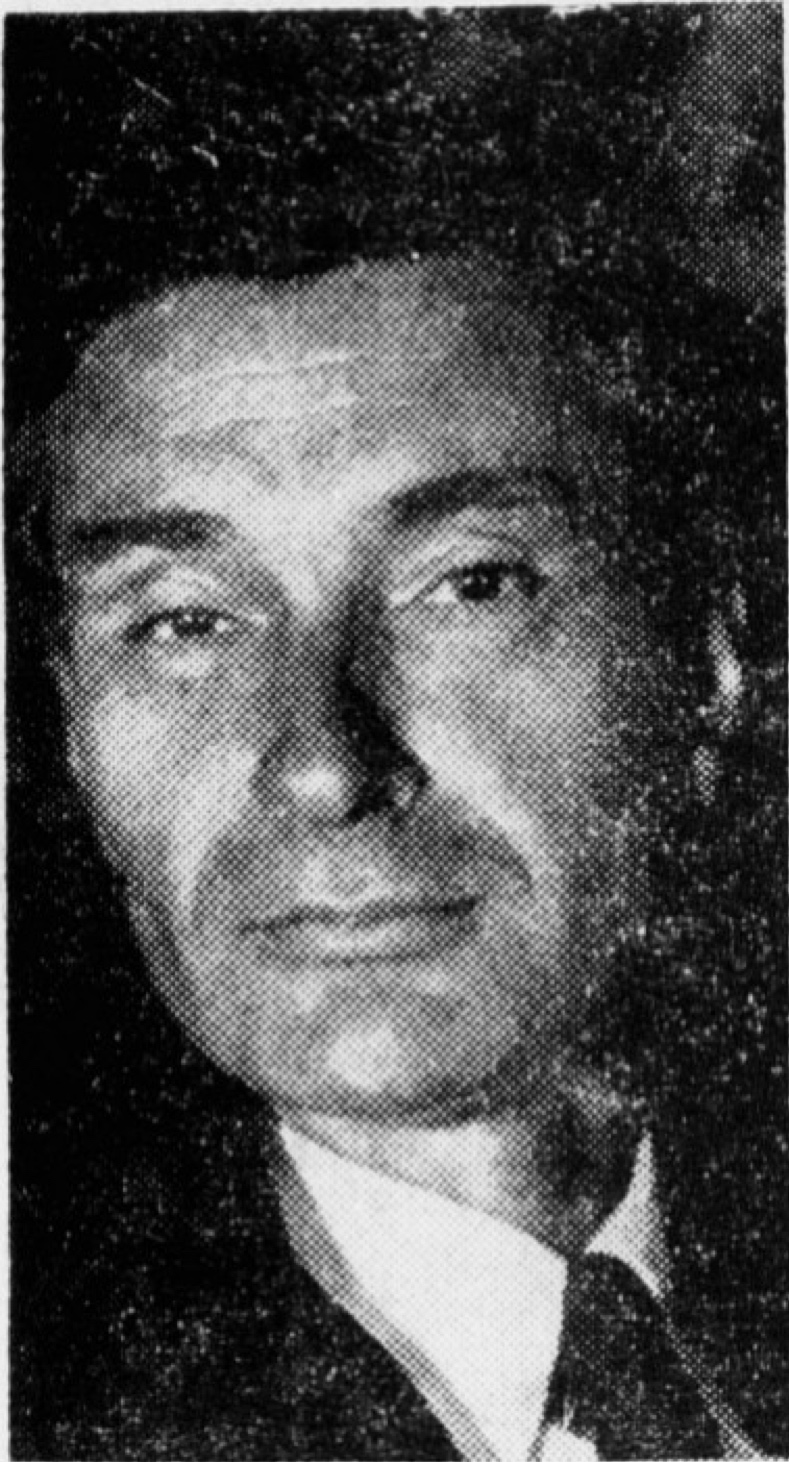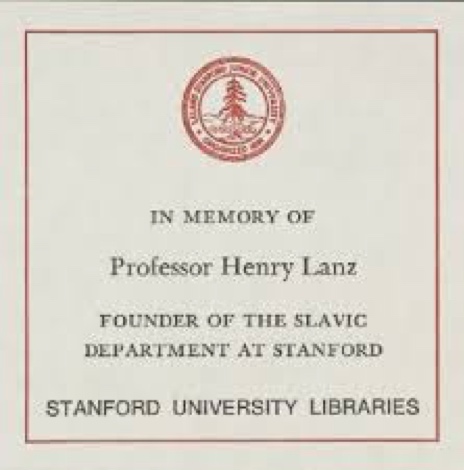Henry Lanz (aka Genrikh Ernestovich Lants) (fig. 1. The photograph was included in the obituary, “Services for Henry Lanz Held at Stanford Saturday,” Stanford Daily, November 5, 1945, 1; the photographer is unknown) played an important role in Vladimir Nabokov’s life and career. In 1939, Lanz invited Mark Aldanov to teach a summer course in Russian literature at Stanford University. When Aldanov, who was unable to come, declined the invitation, Lanz, at the recommendation of the author of The Fifth Seal, approached Nabokov for the position (see Brian Boyd, Vladimir Nabokov: The Russian Years, Princeton, NJ: Princeton University Press, 1990, 511). This invitation paved the way for Nabokov’s coming to the United States in May of 1940 and helped to launch his academic career in the newly adopted country. The next summer at Stanford, Nabokov taught two courses: “Modern Russian Literature” and “Speech and Drama.” Nabokov’s preparation for the latter resulted in two public lectures, eventually published as “Playwriting” and “The Tragedy of Tragedy” (see Cynthia Haven, “The Lolita Question,” Stanford Magazine, May/June 2006 <https://alumni.stanford.edu/get/page/magazine/home>; Dmitri Nabokov, “Introduction,” in Vladimir Nabokov, The Man from the U.S.S.R. and Other Plays, with Two Essays on the Drama, New York: Harcourt Brace Jovanovich, 1985, 311).

Henry Lanz was born in Moscow in 1886. His parents, father, Ernest (ca. 1841–1906), who came from Harrisburg, Pennsylvania, and mother, Karolina (née Meller, b. ca. 1852), were U.S. citizens who arrived in Russia in 1883. They settled in Moscow, where Ernest held the position of the director of a rail-rolling plant. Both Ernest and Karolina Lanz reportedly had literary interests: Ernest was a close acquaintance of Leo Tolstoy, whereas Karolina was known for her translations, and specifically for rendering Harriet Beecher Stowe’s Uncle Tom’s Cabin into Russian (see O. A. Popova, “Genrikh Lants v istorii neokantiantstva,” abstract of Ph.D. diss., Saratov State University, 2010 <http://www.dslib.net/istoria-filosofii/genrih-lanc-v-istorii-neokantianstva.html>).
Lanz graduated from the historico-philological Department of Moscow Imperial University in 1910. He continued his studies at Heidelberg University under a distinguished philosopher, named Wilhelm Windelband. In 1911, he earned his Ph.D. (magna cum laude) in the history of philosophy (Anon., “Henry Lanz, Builder of the Slavic Department,” Stanford Daily, 11 February 1921, 2), with the thesis “Das Problem der Gegenständlichkeit in der modernen Logik: I. Kants Lehre von der Objektivität” (“The Problem of Objectification in Modern Logic: Immanuel Kant’s Doctrine of Objectivity”). In 1911–13, Lanz went to the University of Marburg to study with Hermann Cohen. The illustrious German Jewish philosopher counted Lanz among his disciples and singled him out for praise during his visit in Russia in May of 1914 (Popova, “Genrikh Lants v istorii neokantiantstva”). Among numerous students from Russia who attended Cohen’s lectures and seminars was Boris Pasternak. Pasternak became acquainted with Lanz in Marburg in the summer of 1912. The poet mentions him in his letters of that period and many years later in Safe Conduct (Okhrannaia gramota, 1931) (see, respectively, Popova, “Genrikh Lants v istorii neokantiantstva ,” E. L. Kudriavtseva, comp., Marburg Borisa Pasternaka (Moscow: Russkii put´, 2001), 75–76, 80; Boris Pasternak, Polnoe sobranie sochinenii s prilozheniiami, 11 vols., Moscow: SLOVO, 2003–5, 3:174 and 560).
Upon his return to the old Russian capital, Lanz taught aesthetics at the Beethoven Institute of Musical Education (aka Beethoven Studio) (see Pasternak, Polnoe sobranie sochinenii s prilozheniiami, 3:560). He also published extensively in numerous periodicals. In particular, his articles appeared in Logos, the international yearbook, recently revived, that focused on exploring various facets of German, specifically neo-Kantian, philosophy (see Ol´ga Popova, “Predislovie k publikatsii,” Logos 6, 2006, 185–86). In 1917, Lanz left Russia for the United States, and since his parents were American citizens, he was admitted to the country without impediment. The following year, he began teaching at Stanford, where he soon founded the Slavic Department (fig. 2; reproduced by permission of Stanford Libraries). Lanz served on Stanford faculty until his death in 1945 (see “Henry Lanz, Builder of the Slavic Department” and “Services for Henry Lanz Held at Stanford Saturday”). His main publications include The Physical Basis of Rime: An Essay on the Aesthetics of Sound (1931) and In Quest of Morals (1941).
Long after meeting Pasternak in 1912, Lanz had another encounter with Russian literati, this time with the two renowned writers, Ilya Ilf and Evgeny Petrov. During their visit in the United States in 1935–36, Ilf and Petrov, inter alia, wished to familiarize themselves with American academic life. To this end, they met with Alexander Kaun and his students. Kaun was professor of Russian literature at the University of California, Berkeley, the author of books on Leonid Andreev (1924) and Maxim Gorky (1931). Incidentally, Nabokov met Kaun in Paris in 1932 (see Boyd, Vladimir Nabokov: The Russian Years, 393). Unlike Kaun, Lanz is not mentioned in the writers’ travelogue, Odnoetazhnaia Amerika (1936), translated into English as Little Golden America (1937). However, in a letter to his wife, Maria, of December 6, 1935, when describing his and Petrov’s agenda for that day, Ilf wrote that they were scheduled to meet Professor Lanz and his students (see, respectively, Il´ia Il´f and Evgeny Petrov, Odnoetazhnaia Amerika. Pis´ma iz Ameriki, Moscow: Tekst, 2004, 301 and 464).
In 1940, Lanz met Nabokov. According to Brian Boyd, he was among those very few at Stanford whom Nabokov “liked to meet socially.” Nabokov often played chess with Lanz and found him to be “delicate, cultured, and talented” (Brian Boyd, Vladimir Nabokov: The American Years, Princeton, NJ: Princeton University Press, 1991, 33). Like Nabokov, Lanz had diverse interests. Aside from his main field of philosophy, Lanz’s interests ranged from “music to mathematics, logic to aesthetics, international affairs to community problems” (Haven, “The Lolita Question”), and of course he was well versed in Russian Literature. One cannot help but wonder whether Lanz and Nabokov talked about Pasternak, whom Lanz knew fairly well in Marburg and whose poetry Nabokov held in high regard (see Vladimir Nabokov, Strong Opinions, New York: Vintage International, 1990, 206). One also wonders whether Lanz ever mentioned to Nabokov meeting Ilf and Petrov in December of 1935, and if so, whether they discussed the authors of Twelve Chairs and of The Golden Calf, about whom Nabokov spoke so highly. He dubbed them, “two wonderfully gifted writers” (Nabokov, Strong Opinions, 87). His beloved character, Timofey Pnin, hailed them as “those joint authors of genius” (Vladimir Nabokov, Pale Fire, New York: Vintage International, 1989, 155).
While socializing with Lanz, Nabokov learned that his Stanford host was a nympholept (see Boyd, Vladimir Nabokov: The American Years, 33). When Nabokov’s first biographer, Andrew Field, asked the writer whether Lanz had served him as a prototype of Humbert Humbert, the novelist, according to Field, responded, “that there was no particular reason why Lanz should have figured particularly strongly in his creation of Humbert[,]” but acknowledged that, while creating Humbert, “I may have had him in the back of my mind” (Andrew Field, VN: The Art and Life of Vladimir Nabokov, New York: Crown Publishers, 1986, 212).

--Gavriel Shapiro, Ithaca, NY
